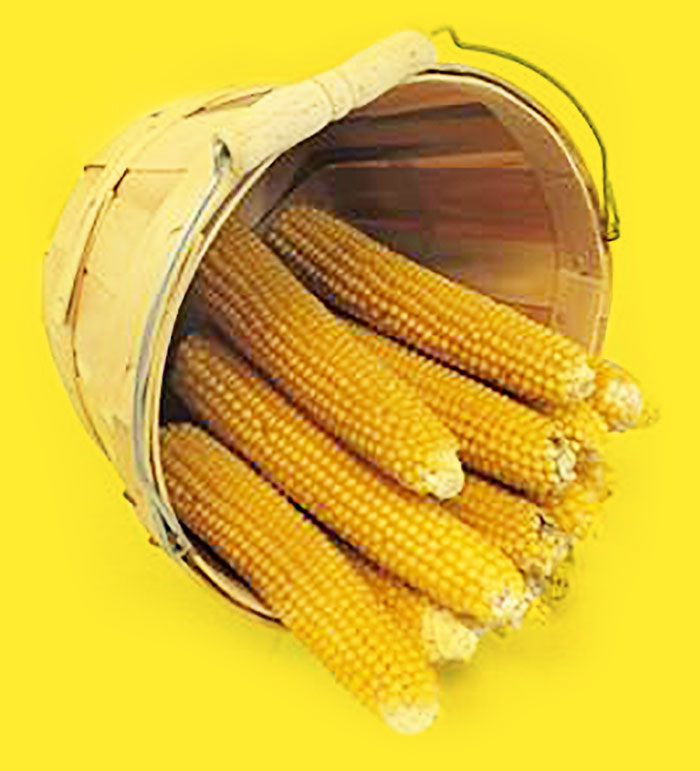Taking an environmentally sensitive approach to pest management
Popcorn: Comfort Food for a Winter Night
Published: November 11, 2019

Although many people enjoy popcorn throughout the year, there is something special about warm popcorn on a cold winter night. Add a bit of warm cocoa or hot spiced cider and you have an idyllic scene reminiscent of a Currier and Ives print. It is little wonder, then, that popcorn sales tend to peak during late fall and early winter each year.
Popcorn is a type of flint corn (Zea mays var. everta) that expands and "puffs out" upon popping. The moisture contained by the kernel's endosperm turns to steam upon being heated. The pressure from the steam ultimately ruptures the hard seed coat and causes a 20 to 50-fold expansion of the original kernel.

DeKalb County (IL) Farm Bureau
Native to the Americas, popcorn was used as a food source by indigenous people long before Columbus arrived. For example, archeologists have traced popcorn consumption in Mexico back to 3,500 B.C. Most likely, Native Americans popped it by placing the corn kernels on stones heated in a fire, or by tossing kernels of popcorn into hot ashes and letting them pop. Later, clay pots were widely used for popping corn.
Apparently, early American colonists did not care for popcorn, and it was not until the late 19th century that eating popcorn became widely popular. A wire basket with a lid and long handle often was used to prepare popcorn over an open fire, gentling agitating the basket until popping was completed. Heavy-bottomed frying pans with a cover also were used. Today, electric poppers largely have replaced their old counterparts.
Popcorn must be cured (dried) properly after harvest for satisfactory popping. Popcorn purchased from supermarkets already will have been cured. For those who grow their own, or purchase popcorn still on the cob, curing most likely will be required. To accomplish the latter, after husking, place the ears in a warm, dry and well-ventilated area such as a basement or breezeway for between two and three weeks.
Although the home gardener has no way to check, popcorn ideally should be cured until it has a moisture content of about 14 percent. At the end of that time, the kernels may be removed from the cob by rubbing one ear against another. Starting from the tip of the ear and working downward makes this task easier.
Corn that is too dry will not pop well. Alternatively, corn with a high moisture content will pop slowly and loudly. Additionally, its kernels will be small and tough.
Once removed from the cob, popcorn kernels should be stored cool. Place kernels in quart jars filled about ¾ full. After sealing, place the jars in a refrigerator or other very cool location. Other moisture proof contains also may be used for storing popcorn.
During the winter when indoor air is very dry, popcorn can lose as much as ½ percent of its moisture content in 24 hours when stored in an open container. As moisture content of the kernels drop, popping becomes less satisfactory. When purchased in plastic bags and not used promptly, popcorn should be transferred to air-tight containers.
Should popcorn become too dry in storage, try adding about one tablespoon of water per quart of popcorn and reseal. Shake the container at least twice daily and test popping quality after several days. If it still does not pop properly, repeat the process. Popcorn that continues to pop poorly should be discarded. Properly stored, popcorn has a useable storage life of several years.
Popcorn essentially has the same cultural requirements as sweet corn. After the soil warms in the spring, plant popcorn in a well-drained garden loam. It is wise to buy popcorn seed with known viability and not use kernels originally purchased for popping. After germination, treat the crop like sweet corn from the standpoint of water and fertilizer. Most productive (hybrid) varieties require 100 days or more to mature.
Pollination sometimes is a concern where space is limited. Since corn is wind-pollinated the possibility exists for cross pollination between popcorn and sweet corn. The latter event can adversely affect the eating quality of sweet corn, especially the "super sweet" types. In small gardens, cross pollination between the two can be prevented by staggering the planting dates of popcorn and sweet corn.
Considered to be a whole grain, popcorn (by itself) is somewhat of a health food. One serving of popcorn will supply about 70 percent of an individual's daily requirement for whole grain. In addition to supplying energy-rich carbohydrates, popcorn is a good source of protein, dietary fiber and other vitamins and minerals. Air-popped popcorn contains only 30 calories per cup.
Unfortunately, large amounts of fat, sugar and salt are often added to popcorn to improve its flavor. The result is a snack that is a poor choice for people with dietary restrictions.
Popcorn trivia:
- Popcorn is America's favorite snack food.
- Two tablespoons of kernels produce about one quart of popcorn
- Americans eat around 17 billion quarts of popcorn every year.
- Regardless of their size or shape, almost all popcorn kernels pop at a temperature of 356°F.
- The world's largest popcorn ball was 12 feet in diameter and weighed 5,000 pounds.
- Originally banned from movie theaters because of the mess it creates, popcorn helped to keep many theaters financially solvent during the Great Depression.
- Charles Cretors patented the first popcorn machine in 1885 in Chicago. Over 100 years later, the company he founded still is manufacturing popcorn poppers.
- In 1896, a street vendor by the name of Frederick Rueckheim perfected a blend of popcorn, peanuts and molassses. He registered the treat as Cracker Jack along with the slogan "The more you eat the more you want".
Subscribe to receive similar articles sent directly to your inbox!
- Popcorn: Comfort Food for a Winter Night (11/11/19)
REVISED: November 11, 2019